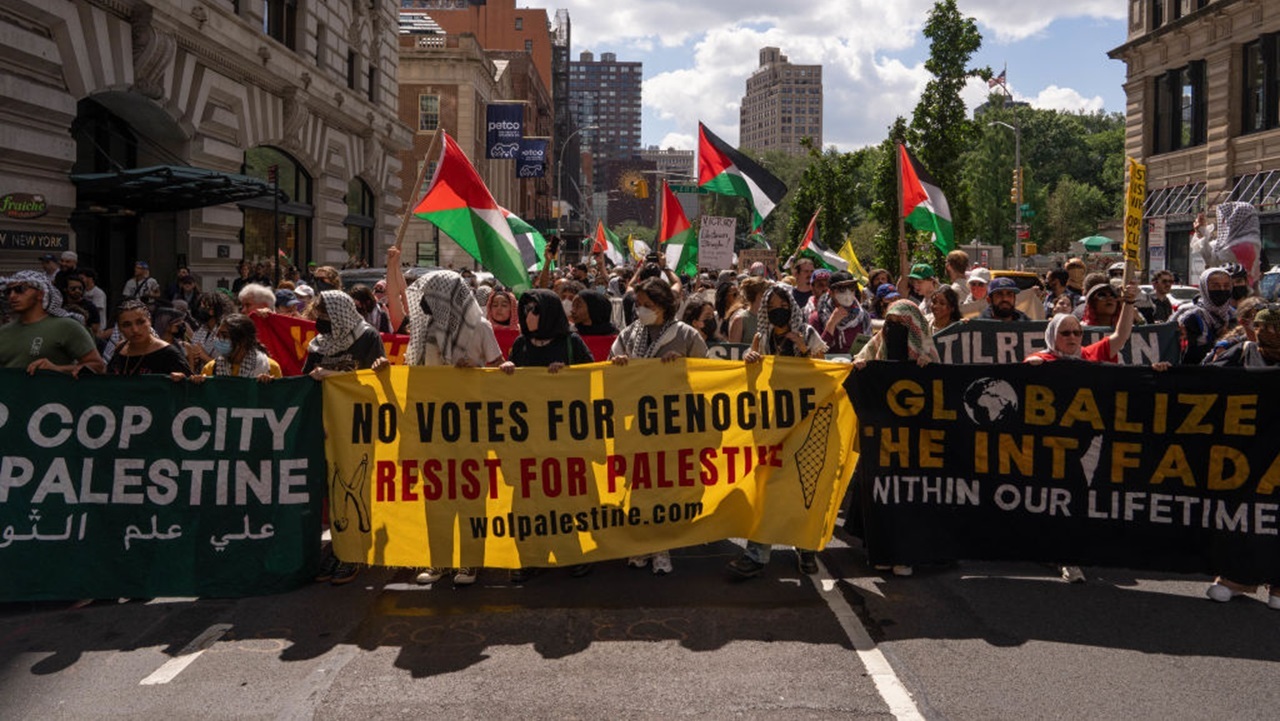
Adam Gray/Getty Images
Anti-Israel protesters hold a rally against the war in Gaza on Labor Day on September 2, 2024 in New York City. A sign calling to 'globalize the intifada' can be seen in the front.
The horrific October 7 attack on Israel by Palestinian terror group Hamas triggered an eruption of antisemitism both on social media and on the ground across the United States.
In the 12 months since the massacre, the ADL Center on Extremism (COE) has tracked key tactics and messaging patterns among activists, influencers and organizations promoting anti-Israel and antisemitic views.
The following are 10 of the most pervasive antisemitic trends that have emerged or intensified in the year since the Hamas attack.

At an anti-Israel march in Union Square on Sep 2, 2024, flags are waved representing Hamas and its military wing, the Al-Qassam Brigades, Hezbollah, Palestinian Islamic Jihad, and PFLP. Protesters with Samidoun waved a banner featuring PFLP's Ahmad Saadat and Hamas leaders Yahya Sinwar and Ismail Haniyeh. (Source: Screenshots from X)
Some anti-Israel activists in the United States continue to demonstrate explicit support for terror groups and figures online and at protests and rallies.
In many circles, praise for Hamas and celebrations of the attack began immediately; COE documented these expressions in the days and weeks after October 7. Since then, the rhetoric has continued in the same vein, even as more details about the brutality of Hamas’s attack came to light. This trend has been particularly notable on college campuses and in street protests organized or co-sponsored by a cadre of anti-Zionist groups.
Protesters regularly indicate their endorsement of groups that the U.S. recognizes as Designated Foreign Terrorist Organizations (FTOs) and Specially Designated Global Terrorists (SDGTs) — including Hamas, Hezbollah, and the Popular Front for the Liberation of Palestine (PFLP) — by cheering their actions in speeches and chants of “Long live the Intifada,” or displaying those groups’ logos and leaders on flags and other paraphernalia.
This support also extends to the Houthis -- a US-designated terrorist group also known as Ansar Allah with a history of antisemitic, anti-Israel and anti-American ideology -- whose endorsement by anti-Israel activists was previously noted by ADL.
These expressions are not limited to a few individuals on the sidelines. Rather, in numerous cities and towns across the country, references to these terrorist groups and their violent actions have been met by raucous cheers from protest attendees, and their symbols have been on display at the protests and in footage posted by organizers.
Examples of this veneration abound: On April 25, 2024, at an encampment protest at the University of California, Los Angeles, messages written in chalk in Arabic read: “Oh Qassam [referencing the Izz ad-Din al-Qassam Brigades, Hamas’s military wing], oh beloved, we want to burn Tel Aviv” and “Oh Abu Obaida [spokesperson for the Izz ad-Din al-Qassam Brigades], we will show you that the Arab people are all with you.” At a protest at Columbia University in New York on April 17, protesters chanted, “Al-Qassam you make us proud, kill another soldier now” and displayed signs bearing the names and images of convicted terrorists and other individuals affiliated with the PFLP and al-Aqsa Martyrs Brigades -- whose acts of violence have included bombings, plane hijackings and more.
Hezbollah flags and a picture of former Hamas leader Ismail Haniyeh, who was killed in late July 2024, were held up by protesters at a rally in New York City following his assassination in Iran. Red triangle imagery, associated with Hamas, is also on proud display at rallies across the country, as well as in memes and graffiti vandalism.
On July 4, 2024, anti-Israel protesters waved Hamas flags, burned a U.S. flag and chanted “Death to America,” over the holiday weekend at a rally organized by radical anti-Zionist organization Within Our Lifetime (WOL).
Protests led or sponsored by anti-Zionist activist group Samidoun and associated groups have also regularly featured flags and imagery associated with terror organizations. At a September 2024 protest in New York, protesters with these groups carried a banner that read "Long Live October 7" and images of terrorists such as Hamas leader Yahya Sinwar, the architect of the October 7 attack.
Recent Harvard CAPS-Harris polls have found that support for Hamas over Israel remains highest among respondents aged 18-24, although support for Israel still generally outweighs support for Hamas in that age group and others.
Related links:
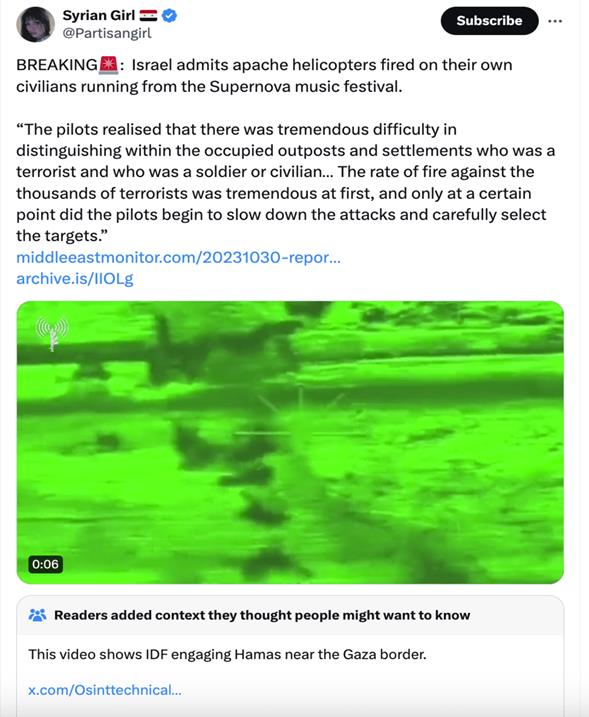
Anti-Zionist influencer “Syrian Girl” shares conspiracy theory about “Apache helicopters.” (Source: Screenshot/X)
Since October 7, extremists and conspiracy theorists have promoted mis- and disinformation narratives about the reality of Hamas’s unprecedented, multi-pronged attack on Israel, attempting to deny, minimize and distort the facts of the terror massacre.
These misleading or false claims proliferated on mainstream social media platforms, invalidating the pain of victims, hostages and their families, and fueling hateful rhetoric against Israelis and Jews.
The disinformation campaigns include unfounded claims that the Israel Defense Forces (IDF) intentionally fired on its own civilians and that Israel “staged” the graphic scenes of families murdered in their homes and people burned alive in their cars across southern Israel during the hours-long attack.
Conspiracy theorists have also attempted to absolve Hamas of any wrongdoing by claiming that they didn’t target or kill any civilians on October 7, despite Hamas claiming responsibility for the attack and terrorists filming themselves committing the acts.
There has also been widespread denial of the sexual assaults that took place on October 7, even as horrific details emerged of Hamas assailants brutalizing Israeli women and girls, parading their broken bodies through the streets. Former Israeli hostages of Hamas have also detailed harrowing incidents of sexual assaults while in captivity.
In addition to the denial, influencers and conspiracy theorists pushed the false theory that the hostages taken by terrorists on October 7 were treated well and /or “adored” their captors. In late November, 105 of the 252 hostages abducted by Hamas were released in a temporary ceasefire. Footage of their release, showing some of them smiling or waving, has become weaponized and distorted to depict Hamas as gracious hosts. The fate of many of the remaining hostages in Gaza is still unknown.
In late August 2024, when Hamas announced that it had executed six hostages including Israeli American abductee Hersh Goldberg-Polin, false narratives and hateful rhetoric spread quickly among antisemites and extremists who suggested that Hamas could not have been responsible and instead attributed their deaths to Israeli bombings or shootings. Others tried to discount the validity of Goldberg-Polin’s identity as an American, calling him a “terrorist” for his time in the IDF.
Another disturbing aspect of denial: the widespread removal or vandalizing of hostage posters across U.S. cities and on college campuses. According to the Center on Extremism’s most recent report on anti-Israel incidents on university campuses, hostage fliers were torn down or vandalized at least 57 times. Additionally, protests targeted at least five campus events that hosted October 7 survivors or their families.
Outside campus settings, there have been dozens of incidents of passersby or activists taking down or damaging posters of hostages. This resulted in physical altercations in some cases.
Also notable is the defense of Iranian proxy Hezbollah – which began raining rockets on northern Israel a day after October 7 in a show of solidarity with Hamas – and the minimization of the terror group’s actions.
Related links:
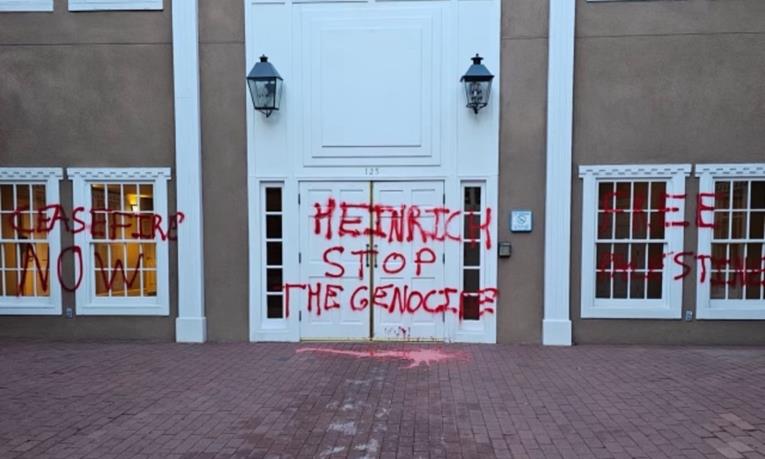
The Santa Fe office of U.S. Senator Martin Heinrich’s (D-NM) was vandalized in November 2023 with graffiti that read “Heinrich Stop the Genocide,” “Ceasefire Now” and “Free Palestine.” (Source: X)
Since the October 7 attacks, political activists have targeted elected officials – and their offices – with protests, harassment and vandalism. Many of these incidents included allegations of support for genocide.
Some of the elected officials who reported being targeted by protestors are Jewish. All have expressed support for Israel, and most have spoken about the need to eliminate Hamas to secure lasting peace in the region. Several have also expressed concern about the large number of civilian deaths in Gaza.
U.S. officials like Pennsylvania Senator John Fetterman (D-PA) and Congressmen Ritchie Torres (D-NY) and Brian Mast (R-FL) have been hounded by protesters for months at or near their offices over their defense of Israel and support for the victims of the Hamas attack.
In July 2024, U.S. Rep. Brad Schneider (D-IL) said his office at the U.S. Capitol was vandalized when posters of hostages taken by Hamas on October 7 were ripped down. Protesters also targeted his private residence in Chicago, arriving overnight outside his house to bang on drums, blow horns, and chant antisemitic and pro-Palestinian chants.
Fetterman’s home in Braddock, Pennsylvania, was also targeted by anti-Israel protesters in January 2024.
The offices of at least a dozen other representatives across the U.S. have been vandalized with graffiti, red paint and anti-Israel slogans and messages since October 2023.
Governors have also been targeted. For example, anti-Israel protesters showed up in the middle of the night outside Illinois Gov. Jay Robert Pritzker’s home in Chicago in July 2024 to hold a rally calling for divestment from Israel.
Related links:
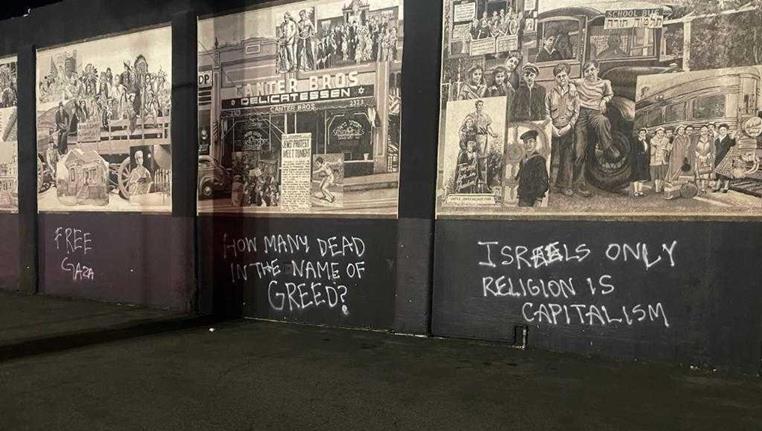
A picture shared on X by ADL California on November 1, 2023, showing the defacement of Canter’s Deli in Los Angeles. (Source: ADL California on X)
Synagogues and other spaces with obvious links to or symbolism for the Jewish community have been targeted repeatedly for protests and harassment since October 7. Some blame Jewish public officials and businesses for Israel’s actions in the country’s war against Hamas.
On October 7, 2023, an individual shouted “Long live Hamas” at a synagogue in Clifton, New Jersey, during Simchat Torah celebrations. Ten days later, a synagogue in Hoboken, New Jersey, received an antisemitic message through its online contact form that read: “Nothing nicer than seeing dead Jews littered on the concert ground like the trash you are. May Christ grant victory to the arabs [sic] to exterminate you Yiddish N-----s from the face of the earth…Die you fucking heeb parasites and may all your children be raped to death.”
On April 1, 2024, a large anti-Israel protest took place in Teaneck, New Jersey outside Congregation Bnai Yeshurun, where protesters repeatedly shouted antisemitic and extreme anti-Zionist rhetoric, including yelling “Go back to Europe!” at Jewish individuals.
In June 2024, anti-Israel protesters attempted to block the entrance to a synagogue in Los Angeles where an event on Israeli real estate investments was taking place – an incident that spiraled into clashes and violence and prompted an FBI investigation.
Museums were also targets for protests and attacks. In July 2024, a flier advertising an anti-Israel event in Farmington Hills, Michigan directed protesters to gather at the local Holocaust Museum. A month later, in August 2024, a man set a fire outside the Jewish Museum in Baltimore, Maryland where authorities are now pursuing hate crime charges.
Jewish and Israeli businesses, owners and patrons have also been targeted. In November 2023, Canter’s Deli, a Jewish-owned business in Los Angeles, was spray-painted with: "Israel's only religion is capitalism," "How many dead in the name of greed" and "Free Gaza.”
A month later, in December 2023, during a march organized by the Philly Palestine Coalition, protestors gathered outside Goldie, a popular Philadelphia falafel shop owned by award-winning chef Michael Solomonov, shouting “Goldie, Goldie, you can’t hide, we charge you with genocide.” The protestors alleged that Solomonov donated a considerable sum to United Hatzalah, a free emergency ambulance service that operates in Israel and the West Bank, and so was targeted for protest.
This type of action continued for months. In January 2024, vandals defaced a kosher restaurant in Teaneck, New Jersey, by covering up the Israeli hostage posters in its windows with signs reading, “Murdered by Israel.” In Houston, Texas, multiple businesses owned by Jewish restaurateur Ben Berg were vandalized in mid-May 2024 with red paint and antisemitic fliers. Anti-Zionist group Unity of Fields (formerly Palestine Action U.S.) celebrated the vandalism, highlighting Berg’s November 2023 participation in a fundraiser organized by the Jewish Federation of Greater Houston to benefit nonprofits supporting Israelis displaced by the October 7 attack and war with Hamas.
In June 2024, patrons waiting to enter an Israeli-owned jazz club in Brooklyn, NY were assaulted by an unknown perpetrator or perpetrators who poured a bucket of red paint on them.
Related links:
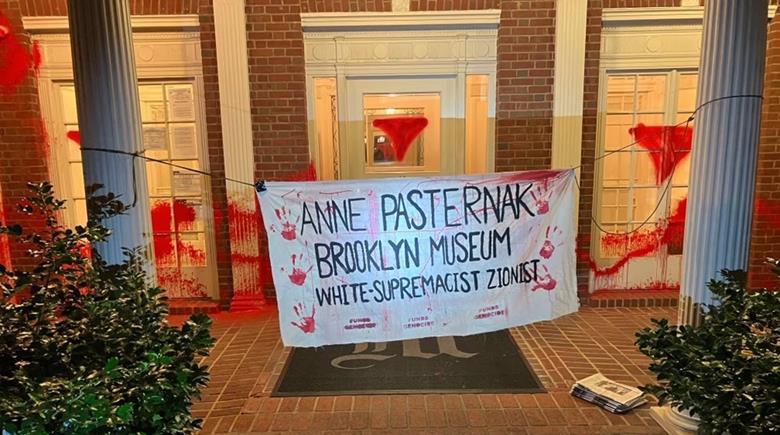
Vandalism at the home of Brooklyn Museum president Anne Pasternak, who is Jewish, on June 12, 2024. (Source: X)
BDS (Boycott, Divestment and Sanctions) campaigns were resurgent following the October 7 massacre. BDS is one tactic in the long history of campaigns and efforts to delegitimize and isolate Israel which in recent years has explicitly focused on the rejection, isolation and marginalization of Zionists.
The latest campaigns directly target “Zionist” institutions, businesses or individuals that BDS activists believe are somehow complicit in Israel’s military response. While some of the targeted business owners and individuals are not Jewish, many are, a reality that underscores the antisemitic impact of these protests and the campaign to discriminate along religious, ethnic and national lines.
For example, in the aftermath of the attack, the Philly Palestine Coalition began circulating a list of “’Israeli’ [quotation marks sic] Food & Zionist Businesses in Philly” to boycott and protest, charging that the restaurants are “appropriating” Palestinian culture and, more importantly, owned by “Zionists.”
In November 2023, an activist released a Google map of “Zionist restaurants” in New York City to boycott, which Google quickly removed, though not before users in the popular kosher Facebook group Great Kosher Restaurants Foodies noted its existence.
In addition, since October 7, BDS activists have intensified calls for action against long-targeted companies as well as new, unofficial targets – like McDonald’s, Starbucks, and Disney -- for their perceived support of Israel. Some of these campaigns -- against weapons manufacturers, food conglomerates and Israeli-owned businesses for example -- have been around for years in one form or another.
At universities and colleges, anti-Israel organizers have called to permanently sever ties with universities, research institutions and other academic programs in Israel, echoing demands long promoted by the U.S. Campaign for the Academic Boycott of Israel (USACBI) and others in the BDS movement.
Notably, many have taken these common BDS directives even further by calling for individual Zionists and Israelis to be banned and boycotted — breaking with USACBI guidelines that specifically advocate for “the boycott of Israeli institutions, not individuals” and which “[reject] on principle boycotts of individuals based on their identity…or opinion.”
Some student protesters punctuated their official demands with even more extreme language in their chants, signs, or other commentary, such as calling for “death” to Zionism and Zionists. In the spring of 2024, student activists built encampments on campus as part of this “student intifada” -- led by Students for Justice in Palestine (SJP) and officially dubbed the “Popular University for Gaza.”
They vowed to end the occupation of public spaces only when their demands for divestment are met – demands that included calls for their universities to withdraw funds and assets invested in Israeli companies and organizations, boycott companies that do business in Israel, and exclude so-called Zionist individuals, organizations and programming from campus.
Some statements put out by encampment protesters echoed classic antisemitic tropes about supposed Jewish power and financial control by attacking “Zionist” trustees and donors and their alleged influence on university affairs.
By the summer of 2024, many anti-Israel activists including those on university campuses began engaging in strategic “escalation” to enforce their demands. As part of this escalation, they expanded their targets to include the private homes and offices of high-profile Jewish and non-Jewish individuals like U.S. officials, university officials, journalists and others. Some also engaged in vandalism and physical takeovers of institutions.
In May 2024, University of Michigan regent Jordan Acker, who is Jewish and has been targeted on multiple occasions, was the victim of a disturbing act of harassment and vandalism at his home as part of the encampment campaign. Acker’s law office was also targeted on June 3, 2024, when multiple masked individuals splashed red paint on the front of the building and spray-painted anti-Israel slogans around the property.
In June, Unity of Fields (formerly Palestine Action U.S.) posted about a series of arson incidents at the University of California, Berkeley. On June 1, a UC Berkeley police car was set on fire while parked on campus. an act the group said was done “in solidarity with the resistance axis for Palestinian life, liberation, and total decolonization of the zionist [sic] occupied lands.”
The group declared: “Blessed is the flame that burns down the settler-plantation. Blessed are the rockets that will free thousands of prisoners held captive by the zionist settler entity and US colonizer police state…Knife to the throat of zionism. Death to amerikkka. Glory to the martyrs.”
On June 13, Unity of Fields commented on a “firebomb” at the university, writing that “EVERY SINGLE BUILDING ON THE UC BERKELEY CAMPUS DESERVES TO BE INCINERATED” and that “UC SYSTEM MUST DIVEST FROM ISRAEL OR FACE OUR WRATH OF REVENGE.” A few days later, on June 16, the group posted about another arson incident at a construction site at UC Berkeley.
On June 17, 34-year-old Oakland resident Casey Robert Goonan was arrested for his alleged connection to the series of UC Berkeley arsons.
In late June 2024, the homes of Anne Pasternak, the Jewish director of the Brooklyn Museum, and other Jewish and non-Jewish members of the museum’s board were vandalized in New York with red paint and inverted red triangles — symbols that are often used to indicate a Hamas target.
The anonymous group that vandalized the director’s house stated it was inspired by a call from Within Our Lifetime “for sustained action against cultural institutions that materially and rhetorically support genocide.” Protesters with WOL had flooded the Brooklyn Museum days prior and unfurled banners denouncing the museum’s “silence on genocide.”
From late May through June, anti-Israel activists affiliated with anti-Zionist group Code Pink and others repeatedly confronted individuals and their families at their homes in Washington, D.C. This included the harassment of CNN anchor Jake Tapper, who is Jewish, and U.S. State Department spokesperson Matthew Miller at their respective houses. The protesters also targeted members of their families, shouting “shame on you” at Miller’s wife and telling Tapper’s children “your dad is lying and killing.”
In September 2024, anti-Zionist activists targeted CNN journalist Dana Bash for protests at her home and at an event for the release of a new book in attacks Tapper described as antisemitic. Bash had been critical of the university protesters.
Related links:
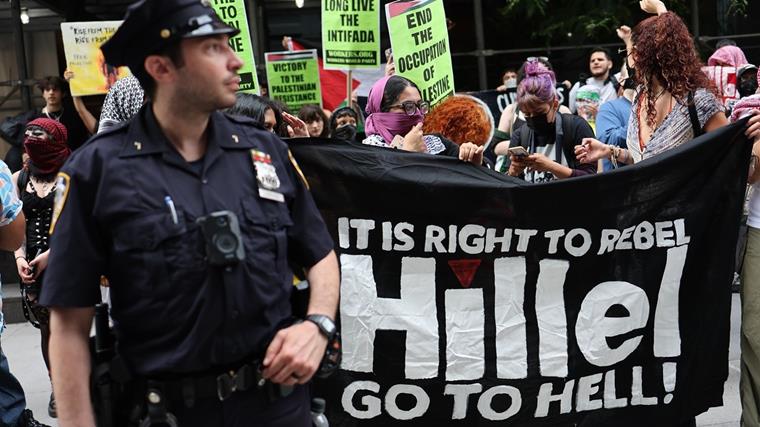
Protesters demonstrate against Hillel at Baruch College, June 5, 2024. (Michael M. Santiago/Getty Images)
At universities and colleges across the U.S., Jewish centers for life on campus such as Hillels and Chabads have become frequent targets of anti-Israel activity since October 7, including harassment, vandalism, and calls for expulsion over the course of the year.
Hillel faced numerous demands for universities to cut ties with or replace them with “non-Zionist” organizations as part of the spring 2024 encampment tactics. Chabad, an Orthodox Jewish Hasidic organization and one of the most significant Jewish religious movements in the world with a considerable presence on U.S. campuses, faced similar calls.
If acted upon, these often extreme, bigoted demands would fundamentally alter Jewish life on college campuses by dismantling or severely limiting essential Jewish communal and academic infrastructure and restricting who can freely exist in these spaces. In some cases, anti-Israel protesters have prevented Jewish students from accessing public areas on campus because they identify as “Zionists,” chanted slogans like “the Zionists have got to go” and disrupted religious activities or other events hosted by Jewish organizations.
Some demands echoed classic antisemitic tropes about supposed Jewish power and financial control by attacking “Zionist” trustees and donors and their alleged influence on university affairs.
Since October 7, targeted protests outside the properties of Hillels and Chabads and the events they hosted occurred on dozens of campuses and sometimes included imagery associated with Palestinian terror group Hamas.
The ADL Center on Extremism’s most recent report on anti-Israel activism on U.S. campuses recorded at least 73 incidents that directly impacted Hillels and Chabads between June 1, 2023, and May 31, 2024. These incidents included Jewish students and Hillel staff members receiving threatening emails and phone calls; Hillel buildings being vandalized and tagged with graffiti; students and staff associated with Hillel being accosted and harassed; and Hillel-sponsored events being protested.
In September 2024, as the 2024-2025 academic school year began, an event organized by the Hillel chapter at Baruch College for Jewish students at Baruch and other institutions in New York City at a kosher restaurant in town was assailed by protesters with the college’s Students for Justice in Palestine (SJP) chapter, who chanted “Baruch Hillel go to hell” outside the eatery, harassed students and threatened violence, and taunted them about the executed hostages.
Related links:

A screenshot of a September 2024 email sent to author Elisa Albert telling her that co-panelists for an event she was due to speak on at the Albany Book Festival did not want to “be on a panel with a ‘Zionist.’” The panel was then canceled. (Source: Screenshot/X)
Increasingly since October 7, Jewish professionals have been subjected to a litmus test about their “Zionist” beliefs, real or perceived, as well as their support for Israel. This is an extension of long-standing “anti-normalization” tactics targeting Israel and Zionist Jews.
The literary field has been especially problematic. In April 2024, literary and free speech organization PEN America called off its annual awards ceremony after dozens of nominees dropped out of the event, citing the organization’s insufficiently critical stance on the war.
A few weeks later, a Google spreadsheet titled “Is your fav author a zionist [sic]” went viral, with lists of Jewish and non-Jewish authors sorted into categories like “Pro-Israel/Zionist,” “Pro-Palestinian/Anti-Zionist” “It’s complicated,” and “Both sides-ing it” based on their social media postings and statements. The list appeared to confirm fears in the industry that professionals who seemed insufficiently critical of Israel were being frozen out. Some named have reported being harassed.
In late August 2024, Jewish author Joshua Leifer, who published a new book about the history of American Jewish identity, had his speaking event canceled at a Brooklyn bookstore after an employee (since fired) objected to the “Zionist” moderator, Rabbi Andy Bachman. Leifer, a progressive, wrote: “My biggest worry was about synagogues not wanting to host me. I didn’t think it would be bookstores in Brooklyn that would be closing their doors.”
In mid-September 2024, award-winning feminist Jewish author Elisa Albert was set to speak on a panel at the Albany Book Festival, but the event was canceled shortly before it was set to start after her co-panelists did not want to “be on a panel with a ‘Zionist,’” according to a screenshot of the email sent to the author by organizers circulated online.
A few months earlier, Jewish actor and author Brett Gelman (“Stranger Things”) said that a series of cancelations in Los Angeles for book signing events for his short story collection was likely due to venues “giving into antisemitic intimidation” amid threats of protests.
These are just a few examples of professionals facing discrimination in the literary and arts and culture spaces.
Others face outright calls for boycotts, including actors, singers, producers and other performers like Natalie Portman, Jerry Seinfeld, Matisyahu, Scooter Braun, Michael Rapaport and “Stranger Things” actor Noah Schnapp, among many others. On X, accounts like “Zionists in Music,” “Zionists in Film” and “Zionists in Publishing” circulate information about individuals in these industries.
Many, but not all, targets of these boycotts are Jewish and/or Israeli, and are accused of “supporting Zionist discourse” or not publicly sharing sufficient outrage at the Israeli military response.
Related links:
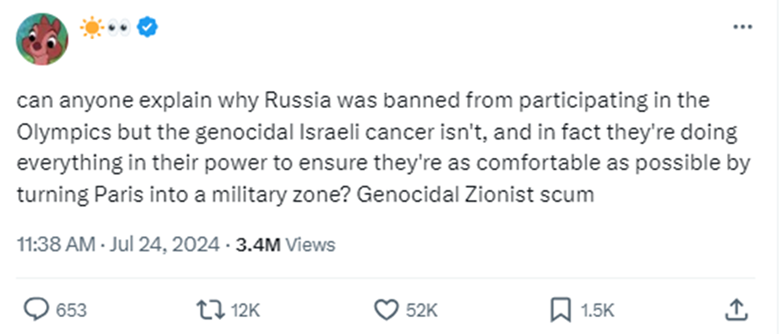
A screenshot from a tweet posted in July 2024 by a radical anti-Zionist and antisemitic account using ‘Zionist’ as a slur. (Source: Screenshot/X)
Increasingly since October 7, the word Zionist – someone who believes in the Jewish people’s right to self-determination – has come to be used as a slur among anti-Israel activists, commentators and antisemites across the political spectrum and as a codeword for a Jewish or Israeli person (or anyone deemed supportive) often with dehumanizing comparisons or calls for harm.
In May, the ADL Center on Extremism tracked an alarming spike on X of phrases or hashtags depicting Zionists as violent, subhuman or mob-like. As of September 2024, X posts using these terms remain popular, and occasionally spike when terms are trending.
Recognizing the use of “Zionist’ as a slur in certain cases, in July 2024, Meta instituted a policy announcing it would begin removing content “that targets ‘Zionists’ with dehumanizing comparisons, calls for harm, or denials of existence on the basis that ‘Zionist’ in those instances often appears to be a proxy for Jewish or Israeli people.”
The explicit endorsement and defense of the ZOG conspiracy theory on the more mainstream left is a newer phenomenon, as reported by the Forward, and reflects the consequences of normalized antisemitic and anti-Zionist rhetoric in these circles. It demonstrates just how widespread and commonplace antisemitic commentary has become — across the political spectrum.
“Zionist” is also being used widely in one iteration of the antisemitic trope about Jewish power and influence. In late July 2024, anti-Zionist commentators and social media users on the left began promoting or amplified the antisemitic trope “Zionist Occupied Government” (ZOG) — a conspiracy theory and phrase typically used by white supremacists which falsely claims that the U.S. government is controlled by Jews.
On X, mentions using ZOG or related terms started surging days after October 7 and have continued to ebb and flow ever since, according to COE research. The data shows a clear and demonstrable increase of these mentions on X since October 7, when compared to the pre-October 7 equivalent period.
Related links:
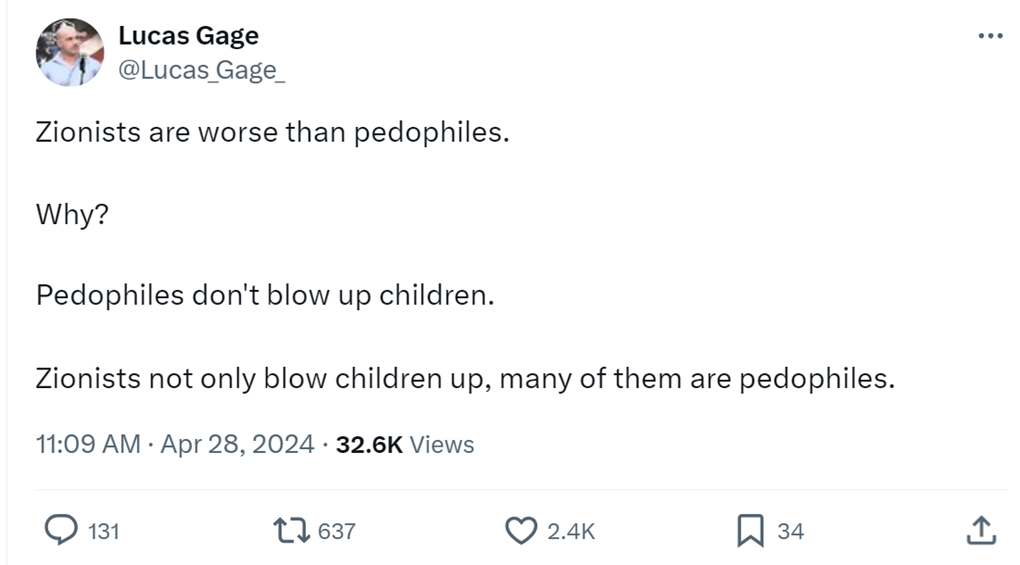
Lucas Gage claims that “Zionists are worse than pedophiles” because they “blow up children.” (Source: Screenshot/X)
In 2023, white supremacists – especially members of Patriot Front – increasingly employed antisemitic and anti-Zionist themes in their propaganda, driving up the year-over-year number of antisemitic propaganda incidents by 30 percent. This trend was also evident following the 10/7 attacks. As white supremacist leaders applauded Hamas and violence against Israelis online, ADL recorded an uptick in antisemitic anti-Israel and anti-Zionist white supremacist propaganda on the ground.
“No more wars for Israel,” the common theme in many post-October 7 incidents, is a longstanding antisemitic slogan embraced and used primarily by antisemites on the far right (such as white supremacists). The slogan falsely implies that Jews/Israel effectively control U.S. foreign policy, and that U.S. military involvement in Iraq, Afghanistan and elsewhere has been solely or primarily for the benefit of Israel.
In other instances, the propaganda was more explicit and included the phrases, “Our tax $ fund Israeli blood lust,” “Zionism = Terrorism,” “Death to Israel,” “Jews aren’t worth dying for” and “End Jewish Terror.”
Similarly, in the months following 10/7, anti-Zionism exploded across the far right, as right-wing influencers have harnessed expressions of anti-Zionism to push explicitly antisemitic rhetoric and conspiracy theories.
The key perpetrators of this trend over the past year include Jackson Hinkle, Lucas Gage, Jake Shields and Sam Parker – all far-right commentators with millions of online followers who began pushing antisemitic content more aggressively since the start of the Israel-Hamas war.
Notably, Hinkle, whose high-engagement content has centered around demonizing Israel and Zionism, was one of the key promoters of the narrative denying that Israeli victims were sexually assaulted during and after the October 7 attacks. He has expressed overt support for Hamas on X, referring to the terror group as “armed resistance” and has also celebrated Iran’s April 2024 drone and missile attack against Israel. On sites like X, he has continued to use dehumanizing rhetoric against Zionists, describing them as propagandists and “Satanic antihuman scum.”
Gage is a far-right, overtly antisemitic influencer who has been spreading false narratives about Jews since long before the start of the Israel-Hamas war, along with blatantly conspiratorial claims about Israel.
In July 2024, Gage appeared at a “Jewish Problem” conference in Kentucky that gathered white supremacists and far-right extremists, as well as Black nationalists and other antisemites, for an event that blatantly promoted anti-Jewish hate. Speakers espoused disturbing rhetoric about Jews and proposed “solutions” to help fight against the “Jewish problem.”
Parker, a failed 2018 U.S. Senate candidate (Utah), conspiracy theorist and antisemite with a large social media fanbase on mainstream platforms, was also at the antisemitic conference. During a roundtable discussion on “solutions to the JP,” Parker advocated for reclaiming “sovereignty” from federal and state governments and “taking back power” from the Jews.
Right-wing provocateur Candace Owens also joined the anti-Zionist fray, particularly after October 7, routinely promoting antisemitic tropes and spewing antisemitic rhetoric on her podcast and social media channels.
Nicholas Fuentes, a white supremacist leader, organizer and podcaster, has promoted numerous antisemitic conspiracy theories since the Hamas attack, arguing that Jews and Israel control U.S. and global politics.
Related links:
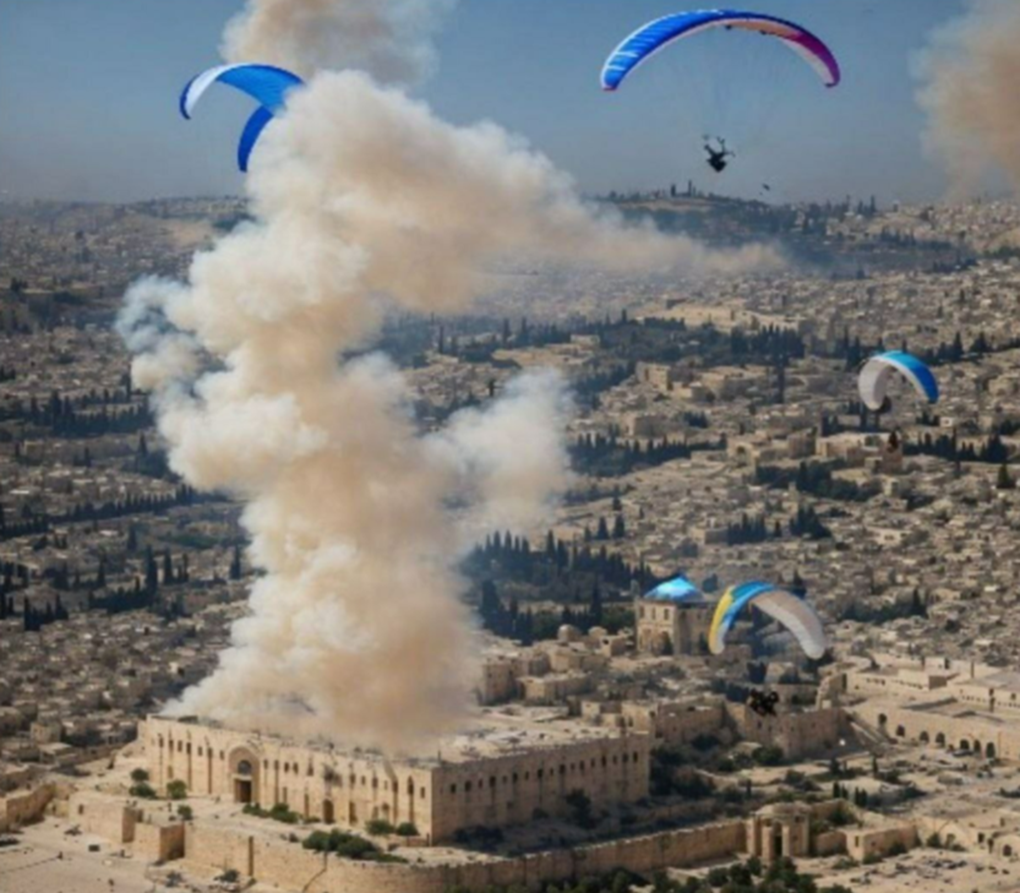
Popular image shared on 4chan shows Hamas terrorists paragliding into Israel and a camouflaged image of Adolf Hitler (Source: Screenshot from 4chan)
Promoters of conspiracy theories and hate have been using generative artificial intelligence (GAI) to create misleading content about the Israel-Hamas war and to push antisemitism.
Innovations in AI technology, plus a wider range of tools available than ever before, have enabled the use of AI image generators for nefarious purposes—some of which have been coordinated and crowdsourced online. This not only amplifies confusion and hate on social media; it can also cause some to doubt the validity of actual war images, creating unnecessary suspicion at a time of deeply polarized public opinion.
In some cases, extremists and antisemitic influencers used AI tools to camouflage hate speech, hate symbols, antisemitic memes and even calls for violence in GAI images.
This is on full display in online discussions about the Israel-Hamas war, as disinformation peddlers use GAI technology to tell a fictional story about the conflict. Many of these images have obvious, tell-tale signs of being inauthentic but can fool the untrained eye and may be difficult to distinguish from the many photos showing actual events in Israel and Gaza.
These tools are also used to spread false narratives and antisemitic conspiracy theories. On Gab, antisemitic influencer Lucas Gage shared a GAI image of a tunnel, which also showed an antisemitic meme known as the Happy Merchant. Gage was referencing the January 2024 discovery of passageway found beneath Chabad headquarters in Brooklyn, New York, which led to a surge in antisemitic rhetoric and conspiracy theories online.
In the spring of 2024, extremists and online trolls harnessed Suno, an increasingly influential Generative Artificial Intelligence (GAI) music creation tool, to make songs promoting hate speech, racist stereotypes, calls for violence and antisemitic rhetoric.
On a Telegram channel dedicated to offensive GAI content, a user shared a blatantly antisemitic song called “My Little Chamber,” which references Holocaust death camps with lyrics about a “striped PJ shirt.”
Another example from a far-right Telegram channel showed how users exploit Suno using deliberate misspellings — in this case, to suggest sarcastically that they can’t wait to “dye” for Israel. This plays on the conspiracy theory that the U.S. is secretly planning to draft citizens into a world war to defend Israel against Hamas (and therefore “die” for Israel).
Related links: